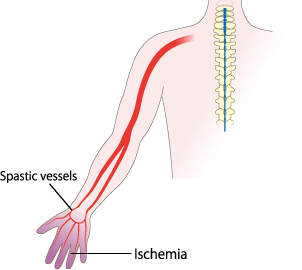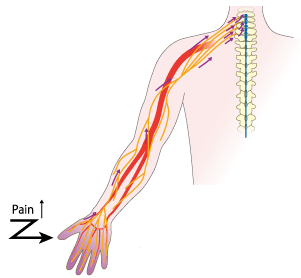- HOME
- For Patients
- Vascular insufficiency pain
Vascular insufficiency pain
- About
vascular insufficiency pain - Diagnosis of
vascular insufficiency pain - Treatment of
vascular insufficiency pain - Spinal Cord Stimulation Therapy
About vascular insufficiency pain
What is vascular insufficiency pain?
If the arteries in the arms and legs constrict, the blood flow below this point decreases, causing a lack of blood in the tissues of the hands and feet. If this lack of blood persists for a long time, the tissues eventually lose their function and become what is known as "necrotic. " The surface of these tissues darkens, and in the worst case, fingers or toes may drop off. The state in which the arteries have narrowed (become spastic) and tissues are starting to lose their function is known as "ischemia. " When an artery contracts, this is called "vasoconstriction, " and vasoconstriction also causes pain. Tissues that have become ischemic also release various substances that intensify this pain into their surroundings, and these substances cause the arteries to contract further, making the pain even worse and closing the vicious circle of pain and ischemia. Patients suffering from this interaction of pain and ischemia are said to be experiencing vascular insufficiency pain.

Ischemia

Pain
Diabetes
Diabetes, one of the most common diseases of adulthood, causes arteriosclerosis. The arteries in the legs below the knee are particularly prone to becoming clogged, and the term "peripheral arterial disease" (PAD) has recently been coined to describe the condition in which small blood vessels in the arms and legs become blocked. The best-known symptom of PAD of the legs is intermittent claudication (limping). In this condition, the feet become painful or numb after walking a small distance, but recover after a short rest. Other symptoms that require vigilance include cold hands and feet and slight injuries taking a long time to heal. PAD is more common in the elderly, smokers, and men.
Buerger’s disease
In this condition, small blood vessels in the hands and feet become blocked. The cause is believed to be inflammation of these small blood vessels, but this has yet to be clearly established. Most sufferers are male smokers under the age of 40. The symptoms include cold hands and feet, pain (even at rest), intermittent claudication, and red, swollen calves.
Raynaud’s disease
In this condition, blood flow decreases in the small blood vessels of the arms and legs. Its symptoms, such as pale, painful extremities, resemble those of Buerger’s disease, but it is most commonly seen in women under the age of 40.







